FORGED by the FIRE
A GLIMPSE OF PERCHERON HISTORY AS A FIREHOUSE HORSE
Not every horse was a viable candidate for serving as a firehouse horse. They had to be incredibly strong, quick, athletic, and fearless. When responding to an incident, these horses had to remain calm as flames and embers mixed with myriad distractions surrounded them at every scene. No other horse has ever stood as tall in the face of such harrowing demands than that of the noble Percheron.
It is difficult to imagine, but most are unaware that horses were not well-received in the firehouse community during the 19th century. In fact, in 1832, the New York Mutual Hook and Ladder Company No. 1 bought a horse to pull their engine, a novel move at that time and one that many speculate was caused by the yellow fever epidemic which precipitated a serious shortage of men. Yellow fever–a viral hemorrhagic disease– spread during the eighteenth and nineteenth centuries and killed more than 100,000 Americans from New Orleans to Boston with the last epidemic departing the infectious disease stage in 1905.
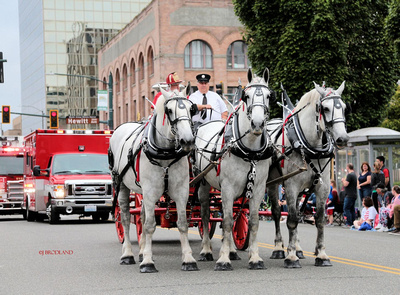 Everett Washington Fire DepartmentGrey Percherons reenact the days of yore by pulling The Continental built by Ahrens Fire Engine Company, Cincinnati, Ohio.
Everett Washington Fire DepartmentGrey Percherons reenact the days of yore by pulling The Continental built by Ahrens Fire Engine Company, Cincinnati, Ohio.
That man-loss devastation is further underscored when one considers that exceedingly heavy steam pumpers and fire equipment were pulled by volunteers; men would gather in large numbers and struggle to drag the heavy equipment to the site of the incident; a process fraught with brutal challenge and one that devoured time critical to saving structures and, ultimately, lives. Necessity is indeed the mother of invention, or in this case, it was a nostalgic intersection of man and horse.
When that first firehouse horse was purchased by New York Mutual Hook and Ladder Company No. 1, neighboring stations averse to the use of horses were so contemptuous and cynical that they entered Ladder Company No. 1’s stable, shaved the horse’s mane and tail, and painted a white stripe down the animal’s back to resemble a skunk. As a further insult, the Oceanus fire company beat the horse-drawn Mutuals to a fire incident. Clearly, a lot of upturns were in order to establish parity, and those who believed in a joint endeavor between man and horse rallied to make that happen.
 3-horse-team-pulls-steam-powered-pumper Steam Powered PumperA three horse team pulls a steam powered pumper.
3-horse-team-pulls-steam-powered-pumper Steam Powered PumperA three horse team pulls a steam powered pumper. 
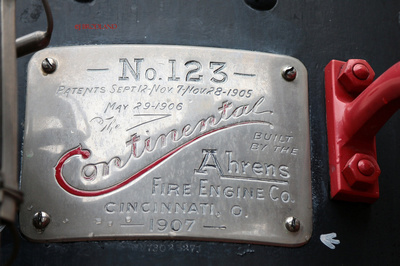 3-horse-team-pulls-steam-powered-pumper Steam Powered PumperA three horse team pulls a steam powered pumper.
3-horse-team-pulls-steam-powered-pumper Steam Powered PumperA three horse team pulls a steam powered pumper. 
As steam engines gained repute and usefulness, they understandably grew in size and weight. Early firefighters, albeit reluctantly, began to view horses as far more compulsory to incident response and success, and it didn’t take long for the resentment to give way to a deep affection for the horse.
In the beginning it was, of course, trial and error. Horses were stabled near the stations, but crews soon realized that when the alarm signaled the menace of fire, precious time was needlessly spent accessing the barn, collecting the horses and harnessing them to the engine. Fire companies were determined to improve, and before long, horses found themselves living at the stations alongside their human counterparts. Hostility toward the horse vanished, replaced by adoration. The men who now doted on their equine partners were some of the very individuals who originally scoffed at the idea that horses could ever be part of a response team.
 WA DC 1914 Fire EngineThe way it looked in 1914, Washington DC
WA DC 1914 Fire EngineThe way it looked in 1914, Washington DC
Skimming the pages of history, the great Chicago fire is a pockmark of unmitigated fire disaster. Legend holds that on October 8, 1871, a cow kicked over a lantern in the barn of Patrick and Catherine O'Leary which resulted in a two-day infrerno that swept the lives of up to 300 people, destroyed 17,450 buildings, left 100,000 people homeless, and was responsible for $200 million in damages. By today's dollars that would be in excess of $4,081,632,653. Other theories of how the Windy City fire- which consumed four square miles- include the speculation that a comet started the fire. Whatever the cause for that historical annihilation, dry weather was a contributing factor which caused two fires per day in the city in 1870 and some of the 20 fires throughout Chicago the week before the Great Fire of 1871.
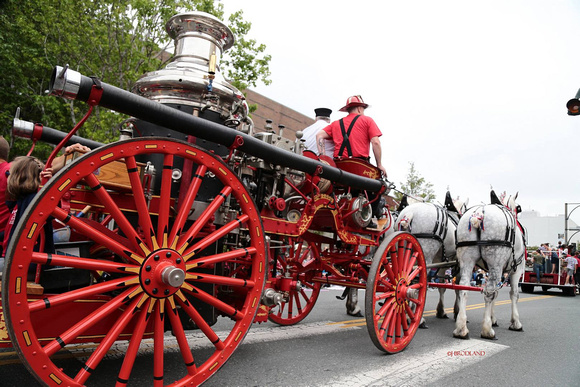 Cash, Cody and Colt Valley View Percherons pulling a 1907 Continental engine for Everett Fire Department
Cash, Cody and Colt Valley View Percherons pulling a 1907 Continental engine for Everett Fire Department
Although the union of horses and fire engines divorced after only fifty years, the glut of fires during that marriage proved educational; modifications with an eye toward enhancement and increased efficiency soon introduced horse stalls into the stations with the firemen, positioned behind or next to the fire rigs. The innovation of a quick-hitch came to fruition, developed by Massachusetts firefighter Charles Berry who created that hanging harness with quick-locking hames. His invention was as practical as it was popular, and he eventually left the fire department, patented his invention, and began a nationwide marketing quest for his Berry Hames and Collars. What is the quick-hitch you ask? With this style of harness, a fire horse could be ready to go in less than a minute. The quick-hitch was a network of leather straps suspended from the ceiling of the firehouse. When the alarm sounded, the horses instantly scrambled into position beneath the harness. At the opportune time, a firefighter manipulated a control switch whereby the harness dropped down around the horses’ bodies.
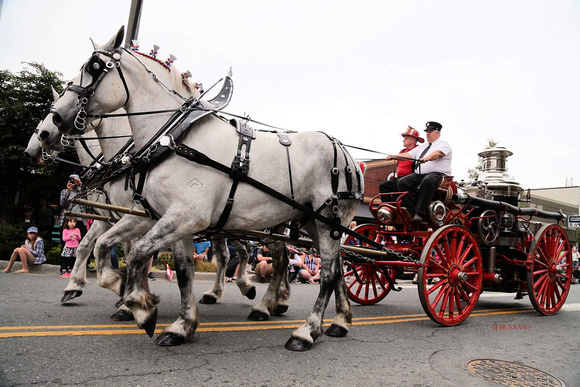 Fire Engine PercheronsEverett Washington Fire Department hosts Valley View Percherons
Fire Engine PercheronsEverett Washington Fire Department hosts Valley View Percherons
Also emerging on the firefighting horizon were new protocols for firehouse horse selection. Fire departments became more discriminating. Both mares and stallions were eligible to serve, and veterinarians carefully evaluated all potential recruits. In Detroit, weight requirements were eventually issued for the horses. For instance, horses pulling a hose wagon were required to weigh at least 1,100 pounds, while a steamer horse needed to weigh in at 1,400 pounds. For horses pulling a hook and ladder, 1,700 pounds was the minimum weight requirement. Stations also embraced uniformity in the horses, striving to create matched teams of two and three horses.
 Everett Fire DepartmentPhoto by Judy Ann Photo of Sedro Woolley, WA
Everett Fire DepartmentPhoto by Judy Ann Photo of Sedro Woolley, WA
Some cities established stables specifically for training firehouse horses, but in the interest of practicality most horses were trained on-the-job. Detroit actually had a horse college and asserted that they were the only fire department to set up such a training regimen. The facility featured a fire station with apparatus, training stalls, quick-hitches, feed room, equine hospital, and a 700-foot racetrack for practice runs. They claimed to be the only fire department to train their horses in this manner. Additionally, horses were issued progress reports and report cards at the close of their tutelage. Horses at the top of the class were quickly assigned tenure with city fire stations with their employment lasting four to ten years. These departments eventually added horse ambulances and farrier wagons to their repertoire. It is interesting to note that in 1858, the Philadelphia Fairmount Engine Company gave their fire horses a vacation each year which quickly became tradition, and it happened long before human firefighters received vacations.
In the fall of 1872 in Toronto, an outbreak dubbed "most destructive recorded episode of equine influenza in history,” known as the Great Epizootic, spread among the horses, and within twenty-four hours, 300 horses died in Buffalo, New York. The equine epidemic spread rapidly to many cities and paralyzed them since all cities now relied heavily on horses for transportation. In late October in Boston, out of a total of 75-90 horses, four had died and 22 were unfit for duty. Until the epidemic ended, firefighters with the aid of citizen volunteers often found it necessary to drag the equipment to fires manually. On November 9th, 1872, the Great Boston Fire burnt continuously for sixteen hours. It consumed 776 buildings, left 20,000 unemployed and 1,000 homeless. There were fourteen fatalities, including eleven firefighters. A century later John P. Vahey, a Boston fire chief, wrote about this catastrophe and renamed it the Epizootic Fire, after the disease that felled so many horses.
It was a sad day at the fire station when a horse was declared unfit for duty. Many retired fire horses continued to work for the city in a less demanding capacity while others enjoyed pasture retirement. Occasionally the horses were put up for public auction, and of those horses which were sometimes purchased by junk drivers and delivery men, the former firehouse horses would forget their new jobs. Many a hollering driver could be seen trying to stop his galloping team as the delivery wagon bounced perilously behind. At the sound of the fire gong, the horses’ allegiance to service was instantly resurrected, and off they charged, looking for a fire.
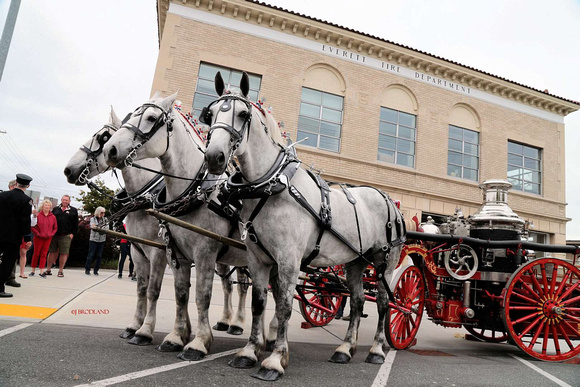 Everett Fire DepartmentCody, Cash and Colt of Valley View Percherons photographed by Judy Ann Photo of Skagit Valley
Everett Fire DepartmentCody, Cash and Colt of Valley View Percherons photographed by Judy Ann Photo of Skagit Valley
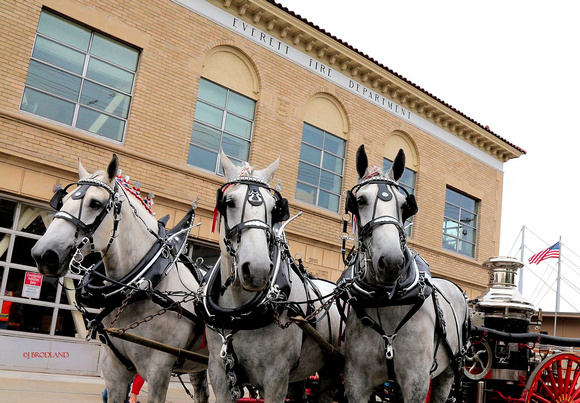 Everett Fire DepartmentCody, Cash and Colt of Valley View Percherons photographed by Judy Ann Photo of Skagit Valley
Everett Fire DepartmentCody, Cash and Colt of Valley View Percherons photographed by Judy Ann Photo of Skagit Valley
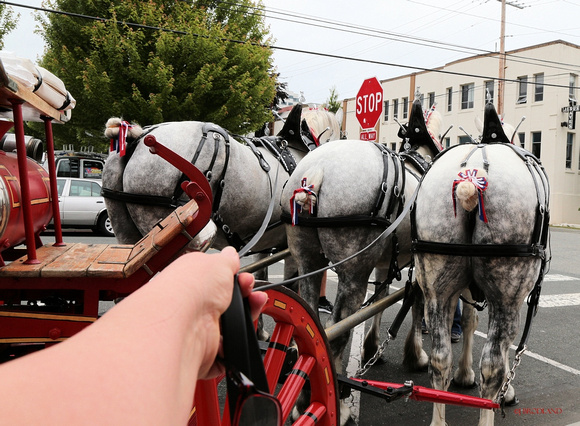 Everett Fire DepartmentCody, Cash and Colt of Valley View Percherons photographed by Judy Ann Photo of Skagit Valley
Everett Fire DepartmentCody, Cash and Colt of Valley View Percherons photographed by Judy Ann Photo of Skagit Valley
Never back down from a challenge: holding three tons of horses and taking the photo.
As published in Percheron News, authored by Judy Ann Photo